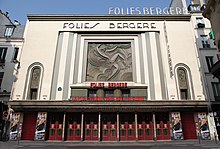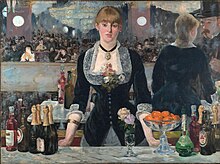The Folies Bergère [1] is a nightclub in Paris which opened in 1869 as a music hall.[2] It was at the height of its fame and popularity from the 1890s until the Second World War. It is still in business.






History
changeIt opened on 2 May 1869 as the Folies Trévise, offering operettas, comic opera, popular songs, and gymnastics. It became the Folies Bergère on 13 September 1872, named after a nearby street, the rue Bergère. [3]
In 1882, Édouard Manet painted the famous A Bar at the Folies-Bergère.
In 1886, Édouard Marchand thought up a new type of entertainment for the Folies Bergère: the music-hall review. Women would be the heart of Marchand's concept for the Folies. In the early 1890s, the American dancer Loïe Fuller starred at the Folies Bergère. In 1902, illness forced Marchand to leave after 16 years.[4]
In 1918, Paul Derval (1880–1966) made his mark on the review. His reviews were to feature extravagant costumes, sets and effects, and his "small nude women". Derval's small nude women would become the hallmark of the Folies. During his 48 years at the Folies, he launched the careers of many French stars including Maurice Chevalier, Mistinguett, Josephine Baker, Fernandel and many others.[4]
Performers
changeMany famous entertainers have performed at the Folies Bergère:
|
Filmography
change- 1936: Folies Bergère de Paris with Maurice Chevalier
- 1956: Folies-Bergère with Zizi Jeanmaire
- 1956: Énigme aux Folies Bergère
- 1991: La Totale!
References
change- ↑ French pronunciation: [fɔ.li bɛʁ.ʒɛʁ]
- ↑ Music hall: might be described as vaudeville or burlesque in U.S. English; and as caberet music-hall or music-hall parisienne in French.
- ↑ Bergère means "shepherdess". Folies meant 'leaves' in Latin, but turned into 'field', then to a place for entertainment. A brief history of the Folies-Bergère Archived 2016-11-08 at the Wayback Machine Art & Architecture
- ↑ 4.0 4.1 Édouard Marchand et les Folies bergère In French with many details and graphics.